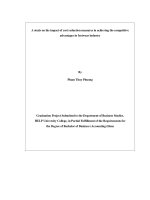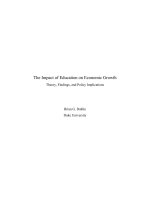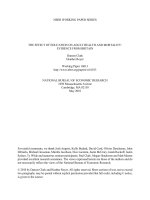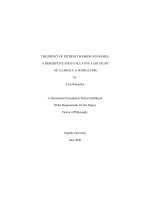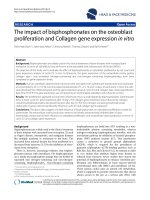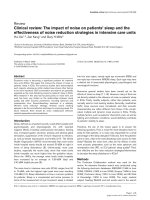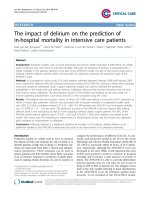The impact of internet on urbanization in china empirical evidence from chinese city level data
Bạn đang xem bản rút gọn của tài liệu. Xem và tải ngay bản đầy đủ của tài liệu tại đây (1.37 MB, 67 trang )
THE IMPACT OF INTERNET
ON URBANIZATION IN CHINA:
Empirical Evidence from Chinese City-Level Data
DUODUO WEI
(MASTER OF SOCIAL SCIENCES), NUS
A THESIS SUBMITTED
FOR THE DEGREE OF MASTER OF ECONOMICS
DEPARTMENT OF ECONOMICS
NATIONAL UNIVERSITY OF SINGAPORE
2011
Acknowledgement
I would like to express my deepest appreciation to those who have helped me
with this thesis.
I owe sincere gratitude to my most respected supervisor, A/P Anthony Chin,
for his patience, encouragement and illuminating guidance. Through the
writing of this thesis, he has spent much time on each of my drafts and offered
me many valuable suggestions. I want to thank him for generously sharing me
his knowledge and time. Without his help, this thesis could not have been
completed.
I would also like to thank A/P Liu Haoming and A/P Shandre M. Thangavelu,
for their insightful inputs and advice during presentation of this thesis.
I
Content
Acknowledgement ......................................................................................................... I
Abstract ........................................................................................................................ III
List of Tables ................................................................................................................ IV
List of Figures ............................................................................................................... IV
1. Introduction .............................................................................................................. 1
2. Literature Review ...................................................................................................... 4
2.1 Urban economic growth and the role of technology (Internet) ..................... 4
2.2 Urbanization and Urban economic growth .................................................... 6
2.3 Other factors influencing urbanization ........................................................... 7
2.3.1 Economic factors .................................................................................. 7
2.3.2 Non-economic factors .......................................................................... 9
2.4 Summary ....................................................................................................... 10
3. Theoretical Framework and Data ........................................................................... 11
3.1 Model set-up ................................................................................................. 11
3.1.1 Urban economic growth and Internet penetration ........................... 13
3.1.2 Urbanization and Urban economic growth ....................................... 15
3.2 Data Availability ............................................................................................ 16
4. Results and Interpretation ...................................................................................... 19
4.1 The relationship between internet penetration and urbanization in China . 19
4.1.1 Result of 2SLS ..................................................................................... 19
4.1.2 Study on Explanatory Variables for Urbanization .............................. 23
4.2 Impact of Internet on Urbanization in China ................................................ 23
5. Conclusion ............................................................................................................... 28
Reference .................................................................................................................... 31
Appendix ..................................................................................................................... 36
II
Abstract
China is experiencing urbanization at an unprecedented rate over the last two
decades. This study explores the effect of internet infrastructure on
urbanization in China, based on a panel data of 39 main cities from 2001 to
2007. Two-stage least square model was employed to ascertain the impact of
internet penetration rate on urban GDP per capita in the first stage. In the
second stage, urban GDP per capita, as well as other urban indicators are used
to explain the degree of urbanization, which is defined in this study as urban
population proportion in the second stage. Consistent with a number of the key
hypotheses, the findings suggest that internet penetration rate has a direct and
significant and positive influence on urban GDP per capita, and an indirect
effect on increasing urban population proportion through urban GDP per
capita. Economic growth continues to fuel China’s urbanization.
Key words: urbanization, internet infrastructure, urban population proportion,
economic growth
III
List of Tables
Table 1: City and Code....................................................................................................... 36
Table 2: Urban population Proportion in 2007 (%) ........................................................... 37
Table 3: Explanatory Variables for Degree of urbanization .............................................. 38
Table 4a: Descriptive Statistics .......................................................................................... 39
Table 4b: Descriptive Statistics ......................................................................................... 41
Table 5: Correlation Matrix ............................................................................................... 43
Table 6: VIF value .............................................................................................................. 44
Table 7: Internet Penetration and GDP per Capita ........................................................... 45
Table 8: GDP per capita and Urban Population Proportion .............................................. 46
Table 9: Test on other explanatory variables .................................................................... 47
List of Figures
Figure 1a: Urbanization Rate (1999-2007) East China 1 ................................................... 48
Figure 1b: Urbanization Rate (1999-2007) East China 2 ................................................... 49
Figure 1c: Urbanization Rate (1999-2007) East China 3 .................................................... 50
Figure 1d: Urbanization Rate (1999-2007) Middle China ................................................. 51
Figure 1e: Urbanization Rate (1999-2007) West China..................................................... 52
Figure 2a: Urbanization Rate and GDP per capita (1999-2007) East China 1 ................... 53
Figure 2b: Urbanization Rate and GDP per capita (1999-2007) East China 2 ................... 54
Figure 2c: Urbanization Rate and GDP per capita (1999-2007) East China 3 .................... 55
Figure 2d: Urbanization Rate and GDP per capita (1999-2007) Middle China.................. 56
Figure 2e: Urbanization Rate and GDP per capita (1999-2007) West China ..................... 57
Figure 3a: Urbanization Rate and Internet Penetration rate (2001-2007) East China 1 ... 58
Figure 3b: Urbanization Rate and Internet Penetration rate (2001-2007) East China 2... 59
Figure 3c: Urbanization Rate and Internet Penetration (2001-2007) East China 3 .......... 60
Figure 3d: Urbanization Rate and Internet Penetration (2001-2007) Middle China ........ 61
Figure 3e: Urbanization Rate and Internet Penetration (2001-2007) West China ........... 62
IV
1. Introduction
Urbanization refers to a process in which an increasing proportion of an entire
population lives in cities and the suburbs of cities. It is also characterized by a
decrease in rural-agricultural activities in favor of urban industrial activities.
This rapid urban transformation has been under way in mainland China since
the early 1980s. China is probably one of the fastest urbanizing countries in
the world. The urban population proportion has increased from 23.01% (1984)
to 44.94% (2007), excluding Hong Kong, Macau, Taiwan. The scale and pace
of China's urbanization promises to continue at an unprecedented rate.1
Urban economists attempted to understand the process of urbanization. This is
because the causal link between economic development and urbanization is
unclear (Jacobs 1970); although it is widely recognized that urbanization is
closely related to economic development (Bairoch 1988). It is most probable
that the forces that influence urbanization interact simultaneously and
reinforce each other. For example, development of urban areas significantly
reinforces urbanization (Mohan 1984; Moomaw and Shatter 1995; Deng et al.
2008).
High-speed internet is seen to aid the industrialization process given its rapid
development since the late 1990s. In March 1999, a low-cost, set-top box was
specially designed by Microsoft Venus2, and introduced in China, enabling
cable TV to the internet connection. Since then internet penetration rate has
increased at a rapid rate (Zhu and He 2002).
1
2
Preparing for China's Urban Billion, McKinsey Global Institute (MGI), March 2008
An project by Microsoft Corporation into the personal computing market in China
1
It is widely recognized that information technology (IT) is critical to economic
growth, and there is much literature that point to the importance of computerbased technology and internet in economic growth (Bresnahan and Greenstein
1999; Roller and Waverman 2001; Jorgensen, Ho and Stiroh 2007). This is in
line with endogenous growth theories (Lucas 1988; Romer 1990), where, the
development of internet technology and relevant innovation helps effectively
distribute information, foster competition, improve industry structure and then
further accelerate macroeconomic growth. Urbanization encourages human
capital accumulation and technology development, and cities become the
engines of economic growth (Bertinelli and Black 2004).
However, there has been little empirical research on the impact of internet
penetration on urbanization in China. The objective of this study is to analyze
the impact of internet development on urbanization in China in two stages.
Stage one tests the effect of internet penetration rate on urban GDP per capita
based on annual panel data of 39 cities, and stage two applies predicted urban
GDP per capita together with other factors as explanatory variables to explain
urbanization. The study suggests that, internet penetration rate has had a
significant positive impact on GDP per capita. Specifically, a 10% increase in
the internet penetration rate has a positive impact on the annual GDP per
capita by 9.74% to 11.15% points (with city and year fixed effect), which
indirectly increase urbanization rate by 2.13%.
There are two main contributions of this study. First, the use of internet
penetration rate as a useful parameter to explain economic growth in China.
2
Second. the use of an instrumental variable which incorporates internet
penetration rate in influencing urbanization.
The remainder of the study is organized as follows. Section 2 briefly
summarizes relevant studies on urbanization and urban economic growth from
previous literature. In Section 3, we develop an Instrumental Variable (IV)
approach, prepare the basic framework and discuss the data resource. Section
4 reports and discusses the results and relationship between internet
penetration and urbanization in China. Section 5 concludes.
3
2. Literature Review
Much has been studied on the relationship between urbanization and urban
economic growth but few on the impact of internet penetration. In this study,
urban economic growth is defined as urban per capita gross domestic product
(GDP).
2.1 Urban economic growth and the role of technology (Internet)
Solow’s economic growth model has formed the basis for many urban
economic growth studies (O’Sullivan 2003). This basic neoclassical model has
been the basis for the study of economic growth at city level. (see Ghali,
Akiyama, and Fujiwara 1978). Crihfield and Panggabean (1995) used
disaggregated data and found that the neoclassical growth model performs
well in explaining inter-metropolitan factor flows and convergence in per
capita incomes.
Hoover (1937) and Chinitz (1961) looked at the impact of externalities on the
urban environments. Information externalities were the driving force for
technological innovation and hence economic growth (Romer 1990). Urban
proximity can reduce the costs of shipping goods and speed the flow of ideas
(Glaeser and Ponzetto, 2007), and empirical work of Glaeser (1996) suggests
that telecommunications may be a complement to face-to-face interactions in
urban areas. All these scale externalities are generated from specialization in
production patterns (Henderson 1974) and knowledge spillover generated
from information exchange. Fujita and Ogawa (1982), Kim (1988), and Black
and Henderson (1999) applied exogenous growth theory at metropolitan level.
Eaton and Eckstein (1997) studied the impact of technology spillovers both
4
within and across cities drawing from data on 39 French urban areas from
1876 to 1990 and 40 Japanese urban areas from 1925 to 1985. It was found
that a significant increase in urban population was associated with the process
of development. Based on Eaton and Eckstein (1997), Black and Henderson
(1999) developed a fully specified endogenous urban growth model, focusing
on issues of city formation and the effect of endogenous growth on changes in
city sizes, numbers, and human capital levels over time, to find that localized
information spillovers fostered endogenous growth.
Industry and internet are intertwined as it enables firms to expand markets and
grow the economy, thus reinforcing urban growth. Internet plays a significant
important role in the information technology (IT) development in the urban
context. Personal computers (PCs) and laptops have become a necessity.
Bresnahan and Greenstein (1999) found that the rapid growth of computer
industry sustained technical innovation and commercialization. Roller and
Waverman (2001) even found that about one third of growth in OECD
countries over the period 1971-1990 can be attributed directly or indirectly to
telecommunications. Internet infrastructure enables the exchange of data
across multiple locations and helps decentralized information processing
(Hayek 1945); improves the processing of information, resulting in significant
growth on firm level (Stiroh 2002); greatly accelerates individual labor
productivity growth (Jorgenson, Ho, and Stiroh 2007); and it also has an
important knowledge spillover effect and create positive externalities, for
instance, helping the presence of complementary inputs such as skilled labor
(Autor, Levy, and Murnane 2003).
5
2.2 Urbanization and Urban economic growth
Based on previous research, the universal acknowledged index for a urbanized
area, is the proportion of the entire population living in urban areas (Davis and
Golden 1954; Moomaw and Shatter 1996; Davis and Henderson 2003;
Bertinelli and Black 2004; Deng et al. 2008). One other commonly used index
is urban population density (people per square kilometer), which has been
frequently used in understanding the and how cities function. Research related
to explaining urban density stride across disciplines, including economics,
health, innovation, psychology and geography. However, given the dynamic
changes in China, city size is constantly adjusted, which makes urban
population density not useful for studying urbanization in China.
The overall growth and expansion of cities has been of long-standing interest
to economists, because strong urban economies are the backbone and motor of
the wealth of nations (Jacobs 1984). The long-term trends of urbanization and
its relationship with economic development remain debatable. However, there
are studies that strongly suggest that urbanization is positively correlated with
economic development.
Mills (1967) suggested that urbanization was a response to per capita income
and employment opportunities provided in cities. Mohan (1984) found Engel
demand effects acted as a catalyst in the urbanization process as development
occur in an economy. In other words, per capita income increase had a
positive effect on urbanization. Moomaw and Shatter (1996) also showed that
a nation’s urban population percentage increased with GDP per capita;
industrialization; export orientation; and possibly, foreign assistance. Davis
6
and Henderson (2003) demonstrated urbanization increases as GDP per capita
rises. It also found that per capita income significantly accelerated China’s
urban expansion, based on a three-period panel data set of high-resolution
satellite imagery data and socioeconomic data as empirical-based evidence
(Deng et al. 2008).
Some studies however demonstrate the lack of relationship between
urbanization and economic growth (McCoskey and Kao 1998; Bertinelli and
Strobl 2003).
2.3 Other factors influencing urbanization
2.3.1 Economic factors
Agriculture’s share in the economy decreases with urbanization (Moomaw and
Shatter 1996). Numerous studies demonstrate that the urbanization is driven
by upgrading of economic structure and the shift from agriculture to industry
and services. As manufacturing and service sector activities develop and
prosper in cities, agriculture’s share of GDP declines, thereafter firms and
workers cluster in cities to take advantage of localized external economies of
scale (Davis and Henderson 2003). Deng et al. (2008) provided empirical
support using Chinese data from the late 1980s to 2000. It was found that
share of secondary industry and tertiary industry in GDP positively influenced
urban core expansion and urbanization in China.
Mills (1967) suggested urbanization might be due to the openness of an
economy. First, it may increase the importance of transportation nodes, which
are present mostly in urban areas. Second, it may increase demand for
7
marketing, financing, and communication (face-to-face contact) making an
urban location more important.
Syrquin and Chenery (1898), in classifying the structure of economies,
concluded that the degree of openness of an economy is important and
suggested indicators such as the share of primary or manufactured goods
exported as a share of exports in GDP as proxy measure.
Urbanization leads to concentration of people in urban areas. This may lead to
inequality in income between urban and rural residences (Kuznets 1955;
Oshima 1962; Becker 1985). However, the income gap might be a pull factor
for people in China to move to cities.
Unlike the early stage of urbanization in European countries, rural migrant
workers in China do not register as urban resident households in short term.
However, they contribute to construction, consumption, economic growth and
urbanization. In 2009, the number of floating population in China was
estimated at 180 million. About 149 million are estimated to be rural migrant
workers. 3 More than 80% floating population in urban areas consist of
peasants from other cities. In the first six months of 2009, there were over 6
million floating workers in first half year of 2009 in Guangzhou. This is about
80% of resident population. 4 These numbers suggest that the income gap
between urban and rural residents is still a pull factor in the urbanization
process.
3
Jiantang MA, Director of National Bureau of Statistics, Press conference, Beijing. January 21,
2010.
4
Review meeting of Comprehensive Security Management, Guangzhou Comprehensive
Security Management Committee. July 24, 2009.
8
2.3.2 Non-economic factors
Lower cost of transportation and communication leads to urbanization as they
facilitate exchange of goods and services and the movement of goods and
people. The size, structure, and efficiency of an urban area are influenced by
the transportation system (Mills 1972). D´emurger (2001), using panel data
from a sample of 24 Chinese provinces between 1985 to 1998 period, showed
that transport facilities did account significantly for observed differences in
growth performance across provinces. Transportation infrastructure reduces
the burden of isolation and speeds up urbanization. Furthermore, improvement
in transportation infrastructure makes traveling faster and more convenient,
and at the same time, reduces the cost of commuting and transportation (Deng
et al. 2008). Transportation costs determine urban spatial size directly (Muth
1969; Wheaton 1974; Deng et al. 2008), as lower transportation costs increase
the urban comparative advantage for both production and consumption
(Graves and Sexton 1979; Mills 1972) and accelerate urbanization.
Energy resource and environment quality are critical determinants of social
sustainability. There has been an increase in research of urban energy
consumption (Huang 1993; Shiu and Lam 2003; Yoo 2005) and environment
protection (Wackernagel and Rees 1996; Bertaud 2003). Historical energy
consumption of Australia, for example, has had significant impact on the
development and operation of cities (Troy et al. 2003). Ferguson, Wilkinson
and Hill (2000) found a strong correlation between city development and
electricity consumption based on data of 100 countries.
9
2.4 Summary
Figures 1, 2 and 3 illustrate urbanization trends, urbanization rates, GDP per
capita, (in RMB) and internet penetration rate for 39 Chinese cities (refer to
Table 1 for city code). Apart for some cities, most exhibit increasing trends.
For example, in 2003, Haikou city (city code 33) merged several neighboring
districts, and increased the urban area to ten times its original size. The
adjustment added a large rural population and seen to indicate a decline in
urbanization rate, as showed in Figure 1c.
A similar reclassification of the urban area in Zhuhai (city code 30) and
Foshan (city code 31) was carried out in recent years. It involved removal of
four counties and integration of the city-level administration. This led to huge
investment in city infrastructure such as subway construction, which attracted
large amount of foreign direct investment from multinational enterprises. All
permanent residents in Zhuhai and Foshan became non-agriculture in the
period 2003 and 2004 respectively due to fast pace of urbanization (see Figure
2c). In the absence of any mergers and expansion, Dongguan’s (city code 32)
rapid increasing GDP per capita did not result in growth in urbanization.
In general, we find a positive correlation between these indicators in most
cities. However, the pace of urbanization differ across different parts of China
(East, Middle and West) urbanization are positively related to GDP per capita
and the spread of internet penetration.
This study attempts to look at urbanization in Chinese cities, by incorporating
internet penetration rate in urban economic growth.
10
3. Theoretical Framework and Data
3.1 Model set-up
Urban Residents in China consist of two groups of people: 1. Permanent
household register of residents, e.g. those considered as “Hukou” 5 holders in
China; 2. Migration residents without “Hukou”.
Economic growth attracts millions of migration workers into cities. This group
plays an important role in Chinese Urbanization Progress, in terms of
infrastructure construction, commodity production and supply, stimulating
domestic demand, and even international trade. They form an indispensable
constitution of population of urban residents.
Thus, we employ the number of average household registers plus two thirds 6
of the Migration residents as Urban Residents for the city. We adopt Urban
Population Portion (urban residents over total population of the city) as the
index of urbanization rate. Since the movement of migration residents is
greatly dominated by the economic level of city, we consider urban population
portion as endogenous, which is driven by economic development.
Substantial research studied on the reverse causality between Urbanization and
Urban economic development. We adopt Internet Penetration rate as an
Instrumental Variable (IV) to help study the impact of internet development
on urbanization for two reasons:
5
Hukou: A certificate of Registered Household. It’s a unique product under Chinese
household register system.
6
The proportion is estimated 2/3 because the overwhelming majority of temporary residents
in cities are rural migrant workers, who live in cities on an average of eight months annually.
11
1. Internet Penetration rate is exogenous in the period (2001-2007) of this
study. It has only eight-year history in China since 1999. Due to lack of
infrastructure foundation and unsophisticated technology, development of
Internet was mostly driven by government policy.
2. Internet Penetration rate, as one form of Information technology, is the
driving force for information externality, technological innovation and hence
economic growth (Romer 1990, Henderson 1974, Eckstein 1997). Substantial
study revealed a great direct effect from information technology (the Internet)
on economic growth. However, the motive for transformation from rural to
urban residents is not purely because of internet infrastructure. Thus, we can
safely affirm an indirect impact of Internet on Urbanization through urban
economic growth.
First, urban economic growth aids in economic structure upgrade. We observe
a shift between different industries as GDP per capita increases. When the
second and tertiary industries develop, peasants view this as an opportunity “to
be liberated” from farming. Second, a booming economy leads to increased
division of labor and larger markets generating economies and efficiency for
mass communication and transportation. This in turn leads to the further
development of urban areas. In addition, growth of the city needs strong
economic and “hard” infrastructure support. Although China is one of the
fastest urbanizing countries, the urbanization level is still below the global
average (see Table 2). Without adequate economic investment in infrastructure
such as transportation systems, utilities and power station, or other basic
facilities, urbanization will not be sustainable.
12
A two-stage least square approach is employed in this study. Stage one applies
a growth model which looks at the relationship between internet penetration
rate and the urban economy. Stage two uses GDP per capita together with
other explanatory variables to explain the impact on urbanization.
3.1.1 Urban economic growth and Internet penetration
The size of an urban economy is measured in several ways, such as the total
value of output (goods and services) produced in urban area (O'Sullivan 2003).
A typical model for the urban economy can be illustrated as follows.
(1)
Mankiw, Romer, and Weil (1992) model augmented Solow’s model to include
accumulation of human capital and physical capital.
(2)
Given constant returns to scale and the three inputs physical capital ( ),
population ( ), human capital ( ), and the state of technology ( ), the steady
state is given by:
(3)
where,
is GDP per capita,
capital,
is average human capital accumulation,
population, and finally,
is the propensity to accumulate physical
is the growth rate of
is the state of the technology, in city at time .
The empirical observations of continuous growth in per-capita GDP can be
expressed by a technological state that increases over time and drives
13
economic growth. Assuming the technological state evolves an exponential
growth path, the state of technology can be written as:
(4)
where,
is the growth parameter of technology development. A permanent
shift in GDP per capita is assumed once internet has been introduced. Internet
penetration in the entire economy may also positively affect urban economic
growth by continuously spurring innovation processes. To model the effect of
internet penetration on economic growth,
can be rewritten as:
(5)
where,
is the specific technology growth parameter for city ,
is the
internet penetration rate, i.e., the share of the population that has subscribed
internet service in city . In the first several years of Internet development in
China, government policy and budgeting plays a very important role, thus we
consider Internet Penetration as exogenous.
Substitute equation (4) and (5) into (3), we obtain,
(6)
and
are fixed for city , and can be merged into the fixed effect of each
city. This yields an econometric, a specification of equation (3),
(7)
Thus,
gives the effect of internet infrastructure on GDP per capita,
captures city-specific effects, and
is an error term.
14
3.1.2 Urbanization and Urban economic growth
Based on Moomaw and Shatter (1996), more factors are included to explain
urbanization, such as, the economic development, technology spread,
communication capacity, living condition, per capita resource and
environment quality, etc. These factors are useful in a comprehensive
evaluation of a city’s development. As showed in Table 3, nine proxies are
employed to explain the corresponding city’s development indices.
In this case, the relationship between the degree of urbanization and relative
city indices is given in equation (8). The abbreviations are explained in Table
3.
(8)
A series of proxies are chosen to express different aspects of urban activities
in the empirical model. These include GDP per capita,
, the indicator of
economic development. GDP measures the value of all goods and services
produced in the city during the year. Primary and tertiary industry as a
proportion of GDP,
and
respectively are also included, to
further indicate the industrial structure, because urbanization speeds up as
industrial structure upgrades (Davis and Henderson 2003). The variable
is measured by actual utilized FDI over GDP to show the degree of
openness of cities.
stands for income ratio of urban and rural residents,
to reveal income distribution and social fairness. As a proxy for transportation
cost, the inverse of road density ( ) measures the railway, road length per
square kilometer. Other variables includes public green space per capita ( ),
per capita electricity consumption ( ), and cell phone penetration rate (
),
15
as proxies for the demand in environment quality, energy consumption and
telecommunication of a city respectively, and are highly related with urban
residents accumulation.
Several assumptions are made. First, we regard the effect of all other possible
factors for urbanization as fixed effect for each city. It rules out the possible
impact of technology development, labor market status, etc. Second, all
explanatory variables are exogenous, due to data limitations.
Therefore, urbanization for city
urban population proportion (
at period
as represented b the variable
) can be explained through equation (9)
as
(9)
where,
capture city specific effects,
captures time fixed effects, and
is
an error term.
3.2 Data Availability
The “city” in China is defined as a local administrative and jurisdictional
entity. There are three different administrative levels of cities in China’s urban
system: municipalities, prefecture-level cities and county-level cities. Small
settlements with township or lower administrative levels are not treated as
“cities”. Scale of urban residents is the major criteria to distinguish cities.
Economic and political importance is also one of the considerations in
defining cities. The definition of cities has largely been consistent with global
definition (Anderson and Ge 2005).
16
39 cities (most are municipalities and some are prefecture-level cities) were
selected based level of economic development, city area, location advantages,
environment, popularity and urban construction, etc. Most cities selected had
urban residents of one million in 2001, and two million by 2007. We also
consider prefecture-level cities based on high reputation, regional and political
status. Urbanization of the prefecture-level city developed very quickly,
especially the prefecture-level cities located within the Yangtze River Delta
and Pearl River Delta (Wang and Han 2009).
China’s National Bureau of Statistics (NBS) reports information on both
“Diqu” (Urban area plus rural area within the same administration) and “Shiqu”
(only urban area). The latter defines the metropolitan area closer to
international standards (Fujita et al. 2004). We employ “Shiqu” in this study.
Internet penetration is measured by the number of internet subscribers per 100
habitants, as defined by China Statistical Yearbook telecommunication portal.
Since internet was introduced to China in March 1999 (Zhu and He 2002),
data is only available from 2001.
GDP is expressed based on 2000 Purchasing Power Parity (PPP). The
propensity to accumulate physical capital is proxied by the ratio of fixed
capital to real GDP. Human capital index is calculated and reported by
China’s National Bureau of Statistics (NBS) based on the China Population
Census in 2000, and is regarded to remain the same until 2007 for each city.
Due to the lack of city-level trade volume data, actual utilized foreign direct
investment (FDI) over GDP is adopted as a measure of the degree of openness.
The income ratio of urban and rural residents is derived from taking the ratio
17
of per capita disposable income of urban households over net income per
capita of rural households.
Amount of urban resident (contain migration residents) is used to derive per
capita indices in the study.
All other data on economic performance and urbanization are obtained from
China Statistical Yearbook, China Regional Economic Statistical Yearbook,
Finance Yearbook of China and China Urban Statistical Yearbook. Some
missing data are obtained from local government statistical yearbooks. Dataset
used is annual up to 2007.
18
4. Results and Interpretation
4.1 The relationship between internet penetration and urbanization in
China
4.1.1 Result of 2SLS
Table 5 reports the correlation matrix of all variables in this study. Some
correlation coefficients are relatively high. To test the severity of multicollinearity problem, we employ variance inflation factor (VIF) and thus is
reported in Table 6. No individual VIF is greater than 10 or Tolerance is
below 0.1. We can therefore exclude for multi-collinearity problems
(Bowerman and O’Connell 1990; Menard 1995).
Table 7 reports estimation results of equation (7) that models the effect of
internet penetration on urban GDP per capita both with and without city fixed
effect. Model 1 refers to the sample of 39 cities with complete data, and,
Model 2 shows results for the same 39 cities, but without controls for physical
and human capital indexes and urban resident growth. A reasonable
assumption made is that internet development leads to innovation in
technology, thereby generating a positive change in physical and human
capital accumulation. Both Models 1 and 2 include on a random effect base
(
in equation (7)). Models 3 and 4 allow for fixed effect for each city
(
in equation (7)).
From Table 7, we observe that the coefficient of the internet penetration rate is
positive and significant in all the four models. As we can expected, the value
is larger from models without controls (1.138>1.051; 1.115>0.974).
19
Since cities in different parts of China are of different economic levels and
environment, we consider the results with city fixed effect (Model 3 and
Model 4) more credible. The F-test of joint significance of fixed effect models
is 15.12 and 14.98 respectively, which reject the null hypothesis of
coefficients jointly being zero. The magnitude of the coefficients suggest that,
given control for city and year fixed effect, a ten percentage point increase in
the internet penetration rate is associated with an increase annual GDP per
capita of 9.74 to 11.15 percent points.
Physical capital and human capital have a positive impact on GDP per capita
while urban resident growth has a negative impact on GDP per capita. This
finding is consistent with Romer (1990), who suggested that a large population
does not necessarily generate growth. However, the effects of the increasing in
the stock of physical and human capital, as well as the development of
technology has a far greater impact on GDP per capita than that of population
growth.
Table 8 reports the results for the second stage. By plugging Predicted value of
Log of GDP per capita in Model 1 of stage 1 into stage 2, we try to study the
indirect impact of Internet penetration rate (IV) on Urbanization. Model 1
strictly follows 2SLS method and reports results on predicted GDP and all
explanatory variables except IV Internet Penetration Rate.
To further study the impact of other variables on Urbanization, Model 2
includes all variables in equation (9), Model 3 reports results without control
for explanatory variables other than economic index, while Model 4 only
controls for predicted GDP per capita (from the first stage).
20


